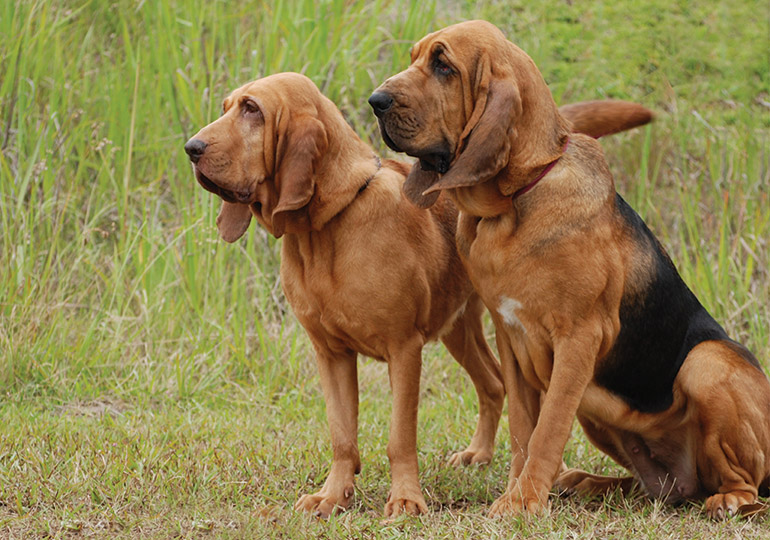
GROUP 4 - HOUNDS
The Bloodhound is an ancient breed originating in France and Belgium. It is unclear whether the name Bloodhound was derived from the blood trail the breed followed after injured game, its long association with the ‘blue bloods’ of royalty, or because of the select breeding to create a scent hound of pure blood.
An affectionate and extremely gentle hound, the Bloodhound is friendly with companions and other dogs, but can also be reserved and sensitive.
The breed can be rather stubborn and Obedience training should be started early, practised regularly and made as much fun as possible. The Bloodhound is easily distracted and training should be kept short.
While it’s beautiful to watch the breed’s head go down and its tail go up as it picks up a scent trail, it’s important to note it can be almost impossible to call a Bloodhound back.
The Bloodhound has a noble and dignified expression, characterised by solemnity, wisdom and power.
A very powerful endurance dog, it can travel over great distances at a steady gait in pursuit of a trail. The skin is thin and loose, especially about the head and neck where it hangs in deep folds. This loose skin serves several useful purposes when the breed is at work, including falling forward to protect the eyes and diminish sight distraction. The head is a key feature of the Bloodhound and is narrow in proportion to length and long in proportion to body, tapering slightly from temples to muzzle.
The breed’s colours are black and tan, liver and tan (red and tan) and red. A small amount of white is permissible on the chest, feet and tip of the tail.
Although a fairly healthy breed, with a life span of eight to 10 years, the breed does have a few health issues that buyers should be aware of. Bloat can be a concern, as are eye problems such as Entropion and there have been some cases of Hip and Elbow Dysplasia. Skin problems can also occur in the breed.
The coat is smooth, short and weatherproof and easily maintained. Regular baths and weekly grooming with a rubber mitt will keep your Bloodhound in good shape. Activities that can help to keep your Hound fit and well, other than a regular daily walk, include swimming, fetch and scenting games, which the Bloodhound loves. The Bloodhound does require some specific maintenance. Those long ears and deep folds need daily attention. A good moisture absorbing powder goes a long way to keeping fungal infections away.
Usually very good with children and other animals, the Bloodhound is not for everyone. The breed can be extremely clumsy around the house and as an adult it can hurl slobber for metres. Bloodhounds require a fully fenced yard and regular daily exercise. The breed needs to be on-lead for any exercise taking place outside a secure area, as that wonderful nose it is known for often leads to trouble.
Words: Carole Bennet
Now you know a little about the Bloodhound you may have think that this is the dog for you. Before you make a decision, please make contact with the breed club or your State controlling body for purebred dogs. They will be able to give you information about available puppies and also suggest dog shows where you can see the breed and speak to breeders. In this way you will gain a better perspective of the Bloodhound and its needs and whether this breed would suit your lifestyle.